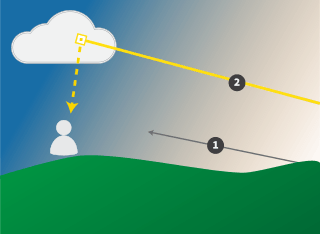Alpenglow



Alpenglow (from German: Alpenglühen, Italian: Enrosadira) is an optical phenomenon that appears as a horizontal reddish glow near the horizon opposite of the Sun when the solar disk is just below the horizon. This effect is easily visible when mountains are illuminated, but can also be seen when clouds are lit through backscatter.
Since the sun is below the horizon, there is no direct path for the sunlight to reach the mountain. Unlike sunrise or sunset, the light that causes alpenglow is reflected off airborne precipitation, ice crystals, or particulates in the lower atmosphere. These conditions differentiate between a normal sunrise or sunset, and alpenglow.[1]
The term is generally confused to be any sunrise or sunset light reflected off the mountains or clouds, but true alpenglow is not direct sunlight and is only visible after sunset or before sunrise.[2]
After sunset, if mountains are absent, the aerosols in the eastern part of the sky can be lit in the same way by the remaining scattered red light straddling the fringe of Earth's shadow (the terminator). This backscattered light projects a pinkish band opposite of the sun.
See also
References
- ↑ "Catch Boulder's 'alpenglow' -- blushing mountains -- this winter". Retrieved 2018-01-10.
- ↑ "What Is Alpenglow?". Digital Photography School. 2012-11-01. Retrieved 2018-01-10.
| Wikimedia Commons has media related to Alpenglow. |